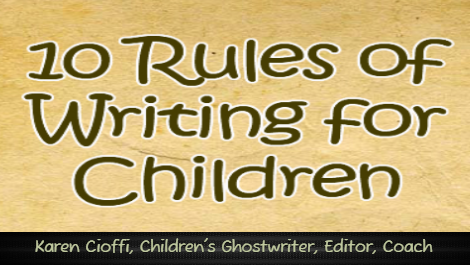Before I became a children’s writer, I wrote marketing and health articles. Writing in multiple genres, I can tell you that writing for children can be much more challenging.
When writing for children, there are guidelines to keep in mind to help your story avoid the editor’s trash pile. And if you’re self-publishing, the children’s writing guidelines help you create an engaging and marketable book.
Here is a list of 10 rules to refer to when writing for young children:
- Keep it safe.
Be sure your story does not suggest dangerous or inappropriate behavior. Keeping children safe is the most important item on this list.
Example: The protagonist (main character) sneaks out of the house early in the morning while his parents are still sleeping.
This is a no-no!
- Age-appropriate words, dialogue and action.
-You wouldn’t use the word remote for a first grader. You would use far.
-A seven-year-old wouldn’t speak like a twelve-year-old.
-A seven-year-old wouldn’t walk a half mile alone to go to a park or go in a pool without adult supervision.
- Age-appropriate problem.
The protagonist should have an age-appropriate problem or dilemma that’s established at the beginning of the story.
Let the action/conflict rise. Then, have the protagonist, through thought process and problem-solving skills, solve it on his own. If an adult is involved, keep the input and help at a bare minimum.
Kids love action and problem-solving!
- Point of view.
The story should have a single point of view (POV). Writing a single POV means that it doesn’t exist if your protagonist can’t see, hear, touch, or feel it.
Example: “Mary crossed her eyes behind Joe’s back.” If Joe is the protagonist, this can’t happen because Joe wouldn’t be able to see it.
- Sentence structure.
When writing for young children, keep sentences short; keep adjectives and adverbs to a minimum. And be careful of your punctuation and grammar.
- Show rather than tell.
Write your story by showing through action and dialogue rather than telling.
You can use your imagination for this one. Picture how the child might behave or react. Will his arms flail? Will he narrow his eyes? Will she cry? Will she run away or stand her ground?
If you can’t seem to find the right words to show a scene, try using dialogue instead; it’s an easy alternative.
- Write tight.
Don’t say something with ten words if you can do it with five.
Watch for unnecessary words (adjectives and adverbs). Use strong verbs. And pay special attention to “ly” words.
- Watch the time frame for the story.
Picture books should be kept within several hours to a day or two. On the outside, a week or two.
A fun story, Stephanie’s Ponytail by Robert Munsch, has a timespan of five days.
- A character arc.
Along with the protagonist’s solution to the conflict, she should grow in some way as a result of the journey.
An example would be if a protagonist starts out unsure and afraid but becomes confident by the end of the story.
- Use a thesaurus and a book of similes.
Finding just the right word or simile can make the difference between a good story and a great story.
Summing It Up.
Using these techniques will help you create effective children’s stories. Another important tool to use in your writing tool belt is joining a children’s writing critique group. No matter how long you’ve been writing, you can always use another set of eyes.
It you’re a beginning writer and unpublished, you should join a group that has published and unpublished members. Having published and experienced writers in the group will help you hone your craft.

I’m a working children’s ghostwriter, rewriter, editor, and coach. I can help turn your story into a book you’ll be proud to be the author of, one that’s publishable and marketable.
OTHER HELP I OFFER:
HOW TO WRITE A CHILDREN’S FICTION BOOK
A DIY book to help you write your own children’s book.
PICTURE BOOK AND CHAPTER BOOK COACHING
Four to ten-week coaching programs.
You can contact me at: kcioffiventrice@gmail.com.
Critiques are Essential for Writers
Submitting Your Manuscript – 8 Tips
Creating Conflict in Your Story



6 thoughts on “10 Rules for Writing Children’s Stories”